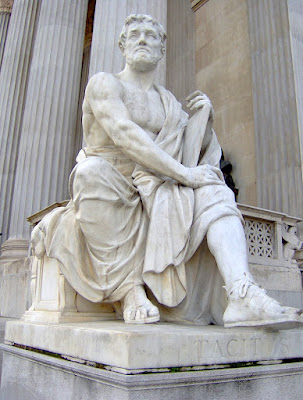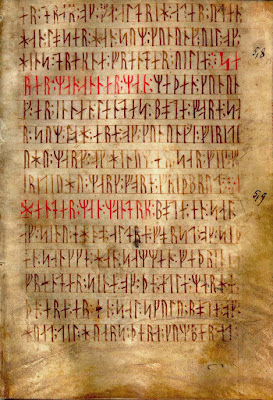Warning: This blog post contains a picture of an actual human skull from centuries ago.
What is this film about, and why should I care about it?
In the fifth century AD, three Germanic tribes invaded the British Isles. They were called the Angles, the Saxons, and the Jutes. Two of them are sometimes lumped together into the term “Anglo-Saxons,” a major group for British history. It is from the word “Angles” that the word “England” itself comes – and, by extension, “English,” the name for the language in which I’m writing this. But this documentary doesn’t just cover the Early Middle Ages – it also covers the earlier “classical antiquity” period, focusing especially on the time of the Roman Empire. The first three episodes focus on the antagonistic relationship between the Romans and the Germanic tribes. Later on, they talk about the fall of the Western Roman Empire, and Europe’s resulting transition into its “Dark Ages” period. Thus, they talk about the bridge between the classical period and the medieval period in this film.
Latest reconstruction of the Sutton Hoo helmet, a famous Anglo-Saxon helmet
This is an English-language adaptation of a German documentary …
But first of all, some basic things about this film, and who exactly was involved in making it. Specifically, this is a German documentary, which was originally made in the German language – although this version is in English. The closing credits were actually in German, and most of the scholars interviewed here seem to have spoken in German, rather than English – although some instead spoke in French, since this topic is of importance for the French as well. But this particular DVD version has only the English-language audio track. That is to say, there is no audio track on this DVD for the original German or French audio, although you can hear the scholars speaking in their native languages, when the English audio is waiting for the native speech to catch up with it. Also, you can hear the scholars’ German and French fade into the background, at the times when the English interpretation is playing over it. Thus, this seems to be thoroughly adapted for the English-speaking market – with the DVD cover even listing a physical address in New Jersey, despite all the things above. They also list their web address as “Kultur.com” – with the “dot-com” being a classic Americanism.
… originally titled “Die Germanen” (the “Ancient Germans” or “Germanic tribes”)
I might also mention that the original German title of this film was “Die Germanen.” Given that the Germans usually refer to themselves as “Die Deutschen” (rather than “Die Germanen”), it would seem that “Die Germanen” refers to the Romans’ Latin-language name for these tribes, from which this German-language name comes (and from which our English word “German” comes as well). That is, the Romans called the region “Germania,” and the people “Germani” – something that we would probably translate as “ancient Germans” or “Germanic tribes.” If the English translation had simply rendered the title as “The Germans” – which I imagine would be a temptation for many translators – some English speakers might have assumed a more modern focus than they would find in this documentary. Thus, “The Germanic Tribes” is probably a better English translation of this film’s title. It better suggests the much older focus of this documentary, which is set primarily in Roman Empire times – although some is in the “Dark Ages,” as I mentioned earlier.
Autumn in Teutoburg Forest, where the Germanic tribes dealt a blow to the Roman Empire
This film has a surprisingly strong focus on the archeology …
This film has a surprisingly strong focus on the archeology. This means that they show a number of physical objects from the past, some of which were discovered in archeological digs. Most of them are now kept in museums. But they also show physical ruins from the past, with occasional computer animation to show what the sites may have originally looked like. Sometimes they also do some forensic analysis of bodies that were discovered in mass graves. This allows them to determine the sex (and approximate age) of the bodies, and to determine how the people died. In one episode, they mention how archeologists discovered the location of the Battle of the Teutoburg Forest. They found a number of bodies there, all of which were later determined to be males in the 20-40 age range. In other words, all of them were determined to be of military age at the time that they died. This was consistent with the soldiers from the two sides, as were the indications of violent death for all of them. I will not go into the other aspects of their analysis, because some of them are somewhat gruesome. But suffice it to say that they helped to confirm the hypothesized site as the location of this battle.
A bog body, the Osterby Man, displaying the Suebian knot, a hairstyle which, according to Tacitus, was common among Germanic warriors
Difficulties of relying upon written records, particularly from their Roman enemies
But like other archeologists, the scholars also have to make use of period writings. This is true whether they’re using them to determine where to dig, or verifying the details of the accounts themselves. Thus, they make use of these written sources wherever possible. But for early Germanic history, this can be somewhat difficult at times. There are no native Germanic writings for the earliest history – or, at least, none of them are known to have survived. Thus, the only place to turn to is the Roman accounts – which see them in “barbarian” terms. Thus, some of the Roman accounts have to be taken with a grain of salt, but there is one that is somewhat more reliable. This is the Roman historian Tacitus, who wrote a work called “Germania.” This gave a relatively objective account of the early Germanic tribes. Tacitus may have still viewed them as “barbarians,” but this ethnographic study also shows some other aspects of Germanic culture that are a bit more sympathetic. Thus, Tacitus’s account is still useful, and they rely on it extensively in this film’s first and second episodes.
Roman historian Tacitus
Native Germanic religion, runic writings, slavery, and conflict with the Roman Empire
Some episodes discuss the native religious beliefs of the Germanic tribes. Ironically, there are some striking similarities between the Germanic gods and those of their Roman enemies. This is because they were both Indo-European cultures, as evidenced by their languages and their burial practices (and many other things). They also mention battles between the Romans and the Germanic tribes, in which the Romans initially held the upper hand. They also discuss Germanic runes, an early way of writing the Germanic language – or languages, since there may have already been more than one at this time. Unfortunately, these runes have only been partially deciphered by linguists. Among the modern Germanic languages that were first written in these kinds of runes was English, which only later adopted the Latin alphabet that we use today – an ironic legacy of the culture’s Roman enemies. They mention trade between the Romans and the Germanic tribes, and the fact that both sides engaged in slavery. There is dramatization of gladiatorial combat among the Romans, as experienced by some of the slaves captured from the Germanic tribes. They also mention how the Germanic tribes began to get the upper hand over the Romans later on, as the Roman Empire withdrew forces from Europe to fight its enemies elsewhere in the world. Thus, the once-expanding borders of the Roman Empire began to shrink, and the Roman Empire began to fall.
Codex runicus, a vellum manuscript from circa 1300 showing some Germanic runic writings
Germanic tribes raid the city of Rome itself, and the “Dark Ages” unofficially begin
They mention several Germanic raids into the city of Rome itself, including the Sack of Rome in the year 410. The Roman Empire might still have existed on paper, but the “Dark Ages” had unofficially begun. Moreover, the Roman Empire was on its last legs, and would officially fall in the year 476. They mention several things about the Early Middle Ages, as the film transitions into its coverage of the “Dark Ages” (another name for the Early Middle Ages). They mention a Germanic king named “Clovis,” the first Germanic leader to convert to Christianity. Thus, he converted many of his subjects as well. They cover the Alemanni and the Franks (especially the Franks), as they talk about the Germanic legacy in France. Ironically, France gets its name from the Germanic “Franks,” rather than from the Celtic “Gauls” whom it looks upon as its founders. But they don’t really cover the Germanic legacy outside of France and Germany. For example, they don’t mention the Anglo-Saxon invasion of England that I referenced earlier, which was in the period that they covered. They do mention the Anglo-Saxons briefly, since they were among the “Germanic tribes,” but do not mention their moving into England to stay. (I mentioned this earlier because this is the most direct connection to English-speaking culture.) They also don’t cover the Visigoth invasion of Spain, or the Gothic raids into other parts of Europe. Viewers might have to turn to the BBC’s “The Dark Ages: An Age of Light” to get further information on some of these other Germanic groups.
Baptism of Clovis I, the first Germanic leader to convert to Christianity
Conclusion: A good overview of a complex topic
But this is generally a good overview of a very complex topic. They give good visuals (even if they are somewhat low-budget), and give good analysis from archaeologists. Overall, this is the best overview of the Germanic tribes that I have ever heard – or expect to hear. It helped to hear a German perspective on these things, although I also liked that they interpreted this program into English for people like me. This made this film watchable for me, and allowed me to learn much from their analysis. I highly recommend this film to anyone interested in the Germanic tribes, the mid-to-late Roman Empire, or even the early “Dark Ages” – also known as the “Early Middle Ages.”
If you liked this post, you might also like:
Part of a series about
European history
The Germanic Tribes
This list covers Europe through the Renaissance. For Europe since the Renaissance, click here.
Part of a series about
British history
The Anglo-Saxon Colony










No comments:
Post a Comment